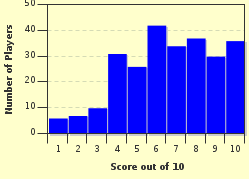Quiz Answer Key and Fun Facts
1. A Number One song in 1964 for four weeks almost matched the six week Number One status it achieved in 1945. Will the lyrical clue which follows help you in coming up with the right answer?
"I've tried to drum up a phrase that would sum up
All that I feel for you
But what good are phrases
The thought that amazes is you love me and it's heavenly"
2. A song introduced in 1927 when it topped the charts of the day for an astounding 14 weeks was revived in 1956 but not quite with similar success... just a modest Number 19 hit. What song featured these lines?
"I'll see a smiling face, a fireplace, a cozy room
A little nest that nestles where the roses bloom
Just Molly and me and baby makes three"
3. A Cole Porter song featured in the Eleanor Powell movie, "Born To Dance", was a Number Three hit for Ray Noble in 1936 while Hal Kemp also scored a Number Eight hit with it that same year. Stan Freberg's parody of the song reached Number 11 in 1951 then in 1966, a rock version recorded by The Four Seasons peaked at Number Nine on the Hot 100. Today, the song is most associated with Frank Sinatra although he never had charting success with it. With the following slice of lyric as a clue, what song was it?
"I'd sacrifice anything come what might
For the sake of having you near
In spite of a warning voice that comes in the night
And repeats, repeats in my ear"
4. Even the Beatles got into the act of resurrecting an old standard. One of their charting singles in 1964, both in America and the U.K., was a song composed in 1927 and a Number One hit that year for Ben Bernie. I can't give you a lyrical clue without giving the answer away, so what song was it?
5. Glen Gray at Number One and Benny Goodman at Number Two had huge success with a Rodgers and Hart composition in 1935. Mel Torme and Billy Eckstine scored minor chart hits with the song in 1949. Then, in 1961, a group from Pittsburgh used it to make their chart debut and topped the Hot 100 for three weeks. Here's one stanza of the song, the only one which doesn't include the song's title.
"And then there suddenly appeared before me
The only one my arms will ever hold
I heard somebody whisper, 'Please adore me'
And when I looked the moon had turned to gold"
Name that tune!
6. "Even Jake, the plumber, he's a man I adore
He had the nerve to tell me he's been married before"
These lyrics come from "Second Hand Rose". It first charted in late 1921 for Ted Lewis at Number Two then charted at Number Three a couple of months later in early 1922 for a vocalist who came to be indelibly linked to the song. Made sense since she debuted it with the Ziegfeld Follies. Then in 1966, Barbra Streisand portrayed her in the movie "Funny Girl" and the song made one last appearance on the Hot 100 at Number 32. As a change of pace, can you identify that original "funny girl"?
7. When I first heard this Number One hit in 1960, it never occurred to me the song was over 30 years old. Actually, it was only while doing research for this quiz that I became enlightened to that fact. Can you identify the song with assistance from the following lyrical sample?
"Other arms reach out to me
Other eyes smile tenderly
Still in peaceful dreams I see
The road leads back to you"
8. In 1932, a Jerome Kern/Oscar Hammerstein II production entitled "Music In The Air" debuted on Broadway. One song from that musical was recorded by Jack Denny's Orchestra and reached a modest Number Ten on the charts. In 1961, a 15 year old named Linda Scott covered that song and managed a Number Three hit on the Hot 100 and Number Seven on the U.K. charts with her version. This might be the most obscure hit featured in this quiz... but I liked the song! I hope these few lines help you in nailing the answer.
"Friends ask me am I in love
I always answer yes
Might as well confess
If I don't they guess"
9. Dick Powell sang a lovely song, written by Harry Warren and Al Dubin, to Ruby Keeler in the 1934 movie "Dames". It was recorded by both Ben Selvin and Eddy Duchin who took it to Number Two and Number Four respectively, later that year. It then reposed in limbo for 25 years before being resurrected as a Number 11 song in 1959. In the Rolling Stone list of best songs of all time, it ranked 157th, much higher than its original Hot 100 chart placement might have warranted if it wasn't such a great recording. Then, in 1975, it charted once again, this time at Number 18 on the Hot 100. Clearly, an estimable entity! Here's your lyrical hint.
"You are here, so am I
Maybe millions of people go by
But they all disappear from view"
Can you identify the song?
10. "I'm paid for every dance, I sell each romance
Every night some hearts I'm betraying
But there will come a day
I know my youth will pass away
And what will they say about me"
These lines come from a 1931 Number One hit. Much later it was the first half of a two song medley that charted at Number 12 in 1985. What was the title of this 1931 song?
Source: Author
maddogrick16
This quiz was reviewed by FunTrivia editor
agony before going online.
Any errors found in FunTrivia content are routinely corrected through our feedback system.

